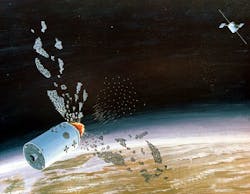Air Force launches Space Operations Initiative to find technologies to control orbital space
Officials of the Air Force Research Laboratory at Wright-Patterson Air Force Base, Ohio, on Friday released presolicitation (BAA-RIK-2015-0001) for the Space Operations Initiative (SOI) project to improve command and control of military space warfare operations.
This project seeks to enable Air Force space operations centers to control space forces and assess space capabilities. It represents the space component of the Autonomy, Command and Control, and Decision Support Core Technical Competency (AC2 CTC) integrated C2 concept, Air Force officials say.
In short, Air Force researchers want to develop technologies that enable space superiority, which describes the ability for U.S. forces to operate freely in space without interference or resistance from adversaries.
Related: Electronic warfare to be part of all military operations
Space superiority involves defensive and offensive space control to enable commanders to plan, direct, coordinate, synchronize, and control operations of assigned forces, researchers say.
The SOI project involves technologies for command and control (C2); electromagnetic spectrum (EMS) visualization; and automated, real-time course of action (COA) generation.
Air Force researchers are asking industry for white papers that provide enhanced event monitoring and task execution, situational assessment, automated decision aids for better course of action analysis and selection, dynamic resource management, and agile C2 enterprise management.
Related: SAIC to produce Battle Force Tactical Network for Space and Naval Warfare Systems Command
The goal is to enable more adaptable, real-time, resilient operations in support of space C2, EMS and COA. Technologies must be compatible with the Joint Space Operation Center (JSpOc) Mission Systems (JMS) Service Oriented Architecture (SOA) and clearly demonstrate measures of performance (MOP) and measures of effectiveness (MOE), researchers say.
Of principal concern are the discovery, development, and generation of near real-time courses of action to help commanders quickly respond to changes in the battlefield of space. In particular, researchers are interested in the ability to command and control space forces based on the current and expected future status of the electromagnetic spectrum.
Funding available for the Space Operations Initiative is about $9.5 million through 2019, Air Force researchers say. Three-to-five-page white papers for automated real-time courses of action are due no later than 17 Nov. 2014.
Related: Air Force cyber warfare experts eye next generation of cryptographic information security
Email white papers to the Air Force's Josh Surman at [email protected]. For questions or concerns contact Josh Surman by email at [email protected], or by phone at 315-330-3416.
More information is online at https://www.fbo.gov/spg/USAF/AFMC/AFRLRRS/BAA-RIK-2015-0001/listing.html.
